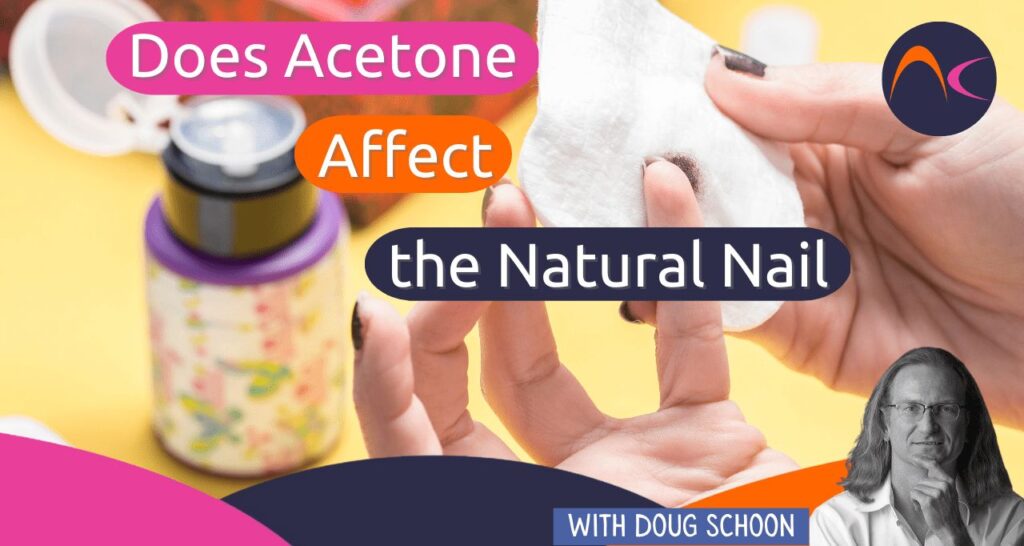We get lots of question addressing in regard to acetone such as these which we will address below:
- What can you tell me about acetone?
- Does it affect the natural nail?
- Does acetone harm the natural nail in any way?
Acetone: A Safe Solvent
Much of what is said about acetone is based on a misunderstanding of this relatively safe substance. Acetone occurs naturally in our bodies in low concentrations. Much of what’s said about acetone is based on fear and misinformation.
If acetone smelled like essential oils, few would be concerned about it. Acetone’s strange odor and odd feel on the skin make many wary. When properly used, it’s a very safe solvent.
Water and Acetone: Similarities and Differences
Water and acetone are very similar in many ways. They are soluble in each other, which show they are similar. Why? The rule in nature is… “Like dissolves like”. Major chemical differences exist between oil and water, which is why they don’t mix.
Acetone and water also have similar effects on the nail plate, but there are differences as well. Both can absorb into the nail plate however acetone evaporates many times faster than water; that’s why it escapes much more quickly from the nail plate than water can, and why it doesn’t accumulate in the nail plate, it’s always evaporating away.
Water wants to stay inside the plate. After acetone is absorbed into the plate, once inside, acetone mixes with the water to form a compatible mixture. These two are so highly compatible, that when acetone evaporates from the nail plate, it carries with it some water from the upper surface layers of the nail plate.
Nail Surface Dehydrators: A Temporary Effect
The same thing happens when rubbing alcohol and water are mixed; they form a compatible mixture and some water evaporates with the alcohol. Since acetone removes water mostly from the surface, this makes the surface of the nail plate much drier, but only temporarily.
Rubbing alcohol or isopropyl alcohol or ethyl ether are examples of other solvents that may be safely used to temporarily remove water from the nail plate’s surface. Ethyl ether has also been used for many years as a nail plate surface dehydrator.
When used as directed these nail surface dehydrators will not damage the nail plate. That’s because the nail plate is only temporarily dehydrated and dehydration is easily reversed without any damage to the surface.
Water flows through the nail plate relatively quickly, these surface cells will only remain in this “drier condition” for somewhere in the range of thirty to forty minutes, depending on the person, or it could take several hours for the plate to completely rehydrate to normal levels.
One major and important difference between water and acetone is how each affects the “oil soluble” substances within the nail plate. Oils and waxes come from the nail bed and surrounding tissues and make up typically 5% of the nail plate or less.
Acetone’s Effect on Oil-Soluble Substances in the Nail Plate
Acetone can dissolve and remove these substances from the surface of the nail plate. This adds to the dry appearance created by the loss of water from the surface. These oils can be replaced by using a high quality, penetrating nail oil.
Even so, the loss of water has a much greater effect on the nail plate. Acetone will remove more water than oil from the surface of the nail. When this occurs, we say the nail is dehydrated, but only the nail plate’s surface is temporarily dehydrated. That is a very important difference.
Visible Effects of Dehydration
Dehydrating the entire nail is very different from removing only surface water and oil. The latter is what acetone does and does well. We can literally see the effects of dehydration. Removing the water from the nail’s surface changes the surface appearance.
Light won’t easily transmit through the surface to illuminate the nail bed, nor will light reflect nicely off the surface to create what we refer to as “shine”. Instead the drier surface is uneven and lacks shine. This is because light is scattered in every direction from surfaces that aren’t smooth. This light scattering makes the nail plate appear whitish in places. Now this is really important to understand.
If a drop of water is placed on a dehydrated surface of a nail plate, the lost surface water is quickly replaced. The result is the “white” surface disappears as the surface layers are quickly re-hydrated, since this is the opposite of dehydrating it makes sense that it would happen.
Water absorbs into the nail plate at relatively high rates, so as I said before, the nail will not stay dehydrated for very long. Even breathing on the nail plate will start rehydrating the surface.
If the white areas don’t disappear even after soaking the nails in water, how can the appearance be due to dehydration? Of course it can’t be and therefore it is not correct to say the nail is “dry”. Yet, this is said quite frequently and it creates confusion.
Mistakenly Blaming Visible Nail Damage on “Dryness”
Often time nail professionals incorrectly blame visible nail “damage” on being “dry nails”. This just shifts the responsibility for the problem in the wrong direction. Surface “damage” such as pits and scratches on the nail plate also scatter light in the same manner as surface dehydration. In other words, surface “damage” can also look much like “dehydration” to the untrained eye, but it is not the same. Water is the perfect test for dehydration. If water is applied onto the whitened areas and it doesn’t disappear, what does this say?
It must not be dry. It’s common to mistake surface roughness, pitting or other damage on the nail surface for so-called “dryness”. This surface whiteness is caused by scraping the nail plate and forcing residual pieces of nail coatings from the nail plate. This damage is completely avoidable, as discussed in later questions.


